A Battle for Kids’ Hearts
DAILY NEWS STAFF WRITER
Tuesday, July 5th, 2005
It was every parent’s nightmare.
Louis Acompora, 14, a goalie on Northport High School’s lacrosse team, had just blocked a shot in the first game of the season.
Seconds later, he collapsed and died.
His horrified parents, John and Karen Acompora, found out later he was a victim of sudden cardiac arrest.
“He just blocked a routine shot with his chest,” said his mother, Karen Acompora. He was otherwise a healthy boy, and was wearing a protective chest plate.
That was five years ago. Since then, the Acomporas have been on a mission to prevent other people’s kids from dying from this sudden killer.
And their efforts – including successfully lobbying for a state law to get public schools to stock lifesaving defibrillators – have saved lives all over New York.
Mohammed Shah, 15, for instance, who collapsed between classes at Smithtown High School, is alive today because of his school’s defibrillator. And East Hampton Middle School custodian Dexter Grady, who suffered sudden cardiac arrest while playing basketball, also owes his life to Louis’ Law.
The Acomporas on Friday received a $5,000 award from Medtronic Emergency Response Systems, which makes automated external defibrillators, at a Jones Beach reception that included a concert by James Taylor.
“We’ve worked in conjunction with Karen and John for a number of years,” said Brian Webster, vice president of Medtronic. “When their son Louis died, they certainly took up the charge of activism to try and solve this. And there have been actual results.”
The Acomporas founded the Louis J. Acompora Memorial Foundation, which sent educational packages – including a book, video and PowerPoint presentation on the defibrillators – to 4,000 schools throughout the country.
And Louis’ Law, signed by Gov. Pataki in 2002, makes it mandatory for public schools to have the special defibrillators – small, lightweight devices that just about anyone can learn to use.
Like Louis, many victims of sudden cardiac arrest haven’t been diagnosed with any kind of heart disease, so the attack is completely unexpected.
In the vast majority of cases in adults, the coronary arteries have been narrowed by fatty buildup.
But when sudden cardiac death happens to younger victims, the cause can be a number of other heart abnormalities, according to the American Heart Association. And adrenaline released during intense athletic activity often acts as the catalyst bringing on the attack like a bolt out of the blue.

